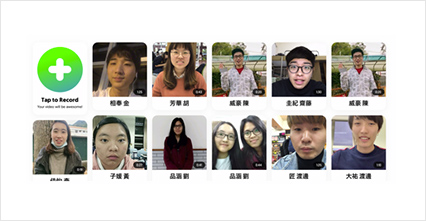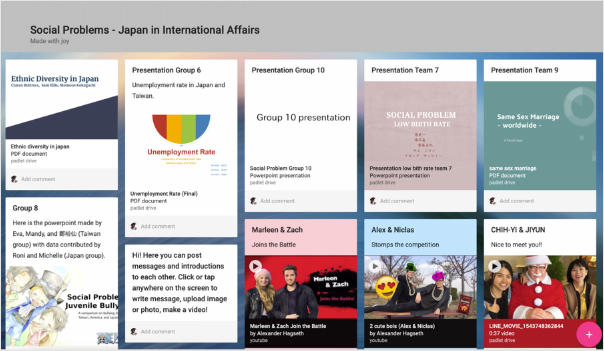2019.03.13About COILCOIL Course Example
Kansai University x Soochow University (Fall Semester 2018)
COIL Course Example 1
This is an example of a mini-COIL project that represents a shorter than usual collaboration that might be suitable for those seeking to undertake a brief version of COIL as an introduction. For example, for those wanting to include some key elements of COIL but lacking experience with tools or those wanting to build a relationship with a partner to enable the development of a standard COIL as a feature of both courses. This example features collaboration between Kansai University (Japan) offering an undergraduate course on Japan in International Affairs, and Soochow University (Taiwan) offering an undergraduate course on Social Problems in Autumn/Winter term 2018-19.
This was undertaken while both courses had already commenced, and was initially conceived as a 2-week virtual exchange that developed into a 4-week mini-COIL. It was conducted primarily as an asynchronous collaboration. For one instructor it was their first experience of actually doing COIL, and it was agreed that a brief COIL project would be the most useful as a means to explore the possibility of doing a standard COIL in the future. Notably, this collaboration overlapped with the new year period 2018-19 when students in Japan did not attend campus (those in Taiwan having regular classes).
The participants included 24 Kansai University students and 30 Soochow University students. Students also included international exchange students enrolled in the courses (e.g., on one or two-semester exchange programs).
The design of this COIL was to enable students to participate in a brief exchange with international students and to collaboratively complete a small project. The rationale of the COIL was that the topic of social problems was very much at the core of both courses, and that students might profit from undertaking a brief project that could explore a social problem that might be shared between Taiwan and Japan – in addition to international students from other countries providing comparison with their home countries. In short, there seemed to be a clear and demonstrable link between the syllabi of the two courses at the level of ‘social problems’, and that COIL could provide the students with an effective way to explore these in terms of regional concerns.
| icebreaking 1 week |
Students used padlet and flopgrid to exchange brief introductory videos (as individual or groupes). |
|---|

| project collaboration 2 weeks |
Students worked on producing slides for a presentation on a shared social problem between Taiwan and Japan (and other countries in some cases) |
|---|

| outputs | Students in Taiwan gave in-class presentation using the slides. Students in Japan made slides available on padlet for discussion. |
|---|
Image:Overview of the COIL project
Icebreaking


Image: Sample of introductory videos using flipgrid
During the icebreaking phase of the project, in the first-week students were given instructions on how to make brief introductory videos using flipgrid and padlet. Padlet was used primarily as a platform to post messages about group membership, course information, and to host final presentations.
Students were assigned to 10 groups (each comprising approximately 3 Taiwan students and 2 Japan students) and instructed they could make video introductions as individuals or as groups. Notably, some student groups made their video introductions more elaborate (using a variety of video editing apps) although this was not an explicit requirement as flipgrid provides basic editing options.
The group list was posted on padlet and sent via email to all students. Students also exchanged email addresses and could exchange SMS details (for many students LINE was a popular app). Instructions on the project requirements were given during in-class sessions. The project required all students to collaborate on producing slides that could be used for a presentation on social problems, with student groups choosing their own topic provided it clearly demonstrated a link between Taiwan and Japan.
While COIL generally requires students to undertake collaborative group projects with a common output, in this case (given the courses had already commenced) the Taiwan students would use the final presentation slides to give an in-class presentation for formal assessment at their campus, and the Japan students would be required to host the final presentation slides on padlet to facilitate in-class discussion for informal assessment. Participation in the COIL combined with regular course participation for the Japan students would make them eligible for a minimum passing grade for the entire course.
Project Collaboration


Image: Padlet showing sample of introduction videos and final group presentations
Following the icebreaking phase, the students (in groups) collaborated on producing a set of slides on a social problem shared between Taiwan and Japan. Students were free to choose the actual topic for investigation. Students used presentation applications (e.g., PowerPoint or similar) for this task. The presentation slides were to be made available to all participants at the end of the COIL exchange. For organization and posting relevant course information, the padlet was the primary tool used.
Outputs
The final presentation slides were used by the students in Taiwan to give an in-class, group presentation that detailed the findings of the collaboration. For the students in Japan, the presentation slides were hosted on padlet and used for group discussion. For a standard COIL project, it would be ideal that the final output represents the entire collaborative project. For example, students could present their findings in a joint video conference (synchronously), or produce a final group presentation video (asynchronously). In the current case this was not possible due to time and resource constraints, but would definitely be the focus for future collaboration.
Summary of Key Elements
| Courses | Japan in International Affairs (Kansai University, Japan) Social Problems (Soochow University, Taiwan) |
|---|---|
| COIL Type | Mini-COIL (2-4 weeks) |
| COIL Rationale | Initial trial to experience COIL. Shared aims of courses relating to international affairs and social problems with regional relevance. Opportunity for intercultural communication and interaction. |
| Students | 54 undergraduate social science/humanities and social work students |
| Collaborative Tasks | Introduction videos Group presentation materials |
| Key Tools |
|